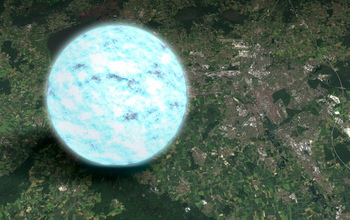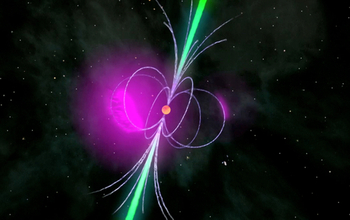All Images
News Release 13-195
Citizen scientists help astronomers see the light
Einstein@Home volunteers find four Gamma-ray pulsars and shed light on another part of the galaxy
This material is available primarily for archival purposes. Telephone numbers or other contact information may be out of date; please see current contact information at media contacts.

A neutron star is the densest object astronomers can observe directly, crushing half a million times Earth's mass into a sphere about 20 kilometers across. This illustration compares the size of a neutron star to a satellite image of the area around Hannover, Germany, hometown of the Albert Einstein Institute Hannover.
Credit: NASA's Goddard Space Flight Center
Download the high-resolution JPG version of the image. (897.0 KB)
Use your mouse to right-click (Mac users may need to Ctrl-click) the link above and choose the option that will save the file or target to your computer.

This is an artist's rendition of a gamma-ray pulsar, a compact neutron star that accelerates charged particles to relativistic speeds in its extremely strong magnetic field. This process produces gamma radiation (violet) far above the surface of the compact remains of the star, for example, while radio waves (green) are emitted over the magnetic poles in the form of a cone. The rotation moves the emission regions across the terrestrial line of sight, making the pulsar light up periodically in the sky.
Credit: NASA/Fermi/Cruz de Wilde
Download the high-resolution JPG version of the image. (932.9 KB)
Use your mouse to right-click (Mac users may need to Ctrl-click) the link above and choose the option that will save the file or target to your computer.


